Hill of Tara
Teamhair | |
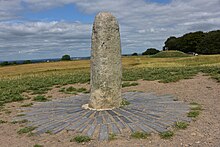 The Lia Fáil (Stone of Destiny) atop the Hill of Tara, with the Mound of the Hostages in the background | |
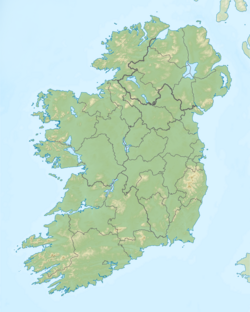 Shown within island of Ireland | |
| Location | County Meath, Ireland |
|---|---|
| Coordinates | 53°34′39″N 6°36′43″W / 53.57750°N 6.61194°WCoordinates: 53°34′39″N 6°36′43″W / 53.57750°N 6.61194°W |
| Altitude | 155 m (509 ft)[1] |
| Type | Ceremonial and burial site |
| History | |
| Periods | Neolithic–Iron Age |
| Cultures | Gaelic |
| Site notes | |
| Ownership | Currently the Irish Government through the Office of Public Works |
| Management | The Office of Public Works |
National Monument of Ireland | |
| Official name | Hill of Tara |
| Reference no. | 676 |
The Hill of Tara (Irish: Teamhair or Cnoc na Teamhrach)[2] is a hill and ancient ceremonial and burial site near Skryne in County Meath, Ireland. Tradition identifies the hill as the inauguration place and seat of the High Kings of Ireland; it also appears in Irish mythology. Tara consists of numerous monuments and earthworks—dating from the Neolithic to the Iron Age—including a passage tomb (the "Mound of the Hostages"), burial mounds, round enclosures, a standing stone (believed to be the Lia Fáil or "Stone of Destiny"), and a ceremonial avenue. There is also a church and graveyard on the hill. Tara forms part of a larger ancient landscape and Tara itself is a protected national monument under the care of the Office of Public Works, an agency of the Irish Government.
Name[]
The name Tara is an anglicization of the Irish name Teamhair or Cnoc na Teamhrach ('hill of Tara'). It is also known as Teamhair na Rí ('Tara of the kings'), and formerly also Liathdruim ('the grey ridge').[3] The Old Irish form is Temair. It is believed this comes from Proto-Celtic *Temris and means a 'sanctuary' or 'sacred space' cut off for ceremony, cognate with the Greek temenos (τέμενος) and Latin templum. Another suggestion is that it means "a height with a view".[4][5]
Features[]
Ancient monuments[]
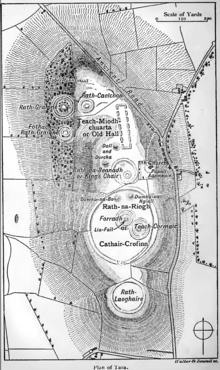
The remains of twenty ancient monuments are visible, and at least three times that many have been found through geophysical surveys and aerial photography.[6]
The oldest visible monument is Dumha na nGiall (the 'Mound of the Hostages'),[7] a Neolithic passage tomb built around 3,200 BC.[8] It holds the remains of hundreds of people, most of which are cremated bones. In the Neolithic, it was the communal tomb of a single community for about a century, during which there were almost 300 burials. Almost a millennium later, in the Bronze Age, there were a further 33 burials – first in the passage and then in the mound around it.[8] During this time, only certain high-status individuals were buried there. At first, it was the tomb of one community, but later multiple communities came together to bury their elite there.[8] The last burial was a full body burial of a young man of high status, with an ornate necklace and dagger.[6]
During the late Neolithic or early Bronze Age, a huge double timber circle or "wood henge" was built on the hilltop.[9] It was 250m in diameter and surrounded the Mound of the Hostages.[6] At least six smaller burial mounds were built in an arc around this timber circle, including those known as Dall, Dorcha, Dumha na mBan-Amhus ('Mound of the Mercenary Women') and Dumha na mBó ('Mound of the Cow'). The timber circle was eventually either removed or decayed, and the burial mounds are barely visible today.[10]
There are several large round enclosures on the hill, which were built in the Iron Age.[6] The biggest and most central of these is Ráth na Ríogh (the Enclosure of the Kings), which measures 1,000 metres (3,300 ft) in circumference, 318 metres (1,043 ft) north-south by 264 metres (866 ft) east-west, with an inner ditch and outer bank. It is dated to the 1st century BC and was originally marked out by a stakewall.[6] Human burials, and a high concentration of horse and dog bones, were found in the ditch.[6] Within the Ráth na Ríogh is the Mound of the Hostages and two round, double-ditched enclosures which together make a figure-of-eight shape. One is Teach Chormaic ('Cormac's House') and the other is the Forradh or Royal Seat, which incorporates earlier burial mounds. On top of the Forradh is a standing stone, which is believed to be the Lia Fáil ('Stone of Destiny') at which the High Kings were crowned. According to legend, the stone would let out a roar when the rightful king touched it. It is believed that the stone originally lay beside or on top of the Mound of the Hostages.[6]
Just to the north of Ráth na Ríogh, is Ráth na Seanadh (the 'Rath of the Synods'), which was built in the middle of the former "wood henge".[6] It is a round enclosure with four rings of ditches and banks, and incorporates earlier burial mounds. It was re-modelled several times and once had a large timber building inside it, resembling the one at Navan.[11] It was occupied between the 1st and 4th centuries AD, and Roman artefacts were also found there.[6] It was badly mutilated in the early 20th century by British Israelites searching for the Ark of the Covenant.[6]
The other round enclosures are Ráth Laoghaire ('Laoghaire's Fort', where the eponymous king is said to have been buried) at the southern edge of the hill, and the Claonfhearta ('Sloping Trenches' or 'Sloping Graves') at the northwestern edge, which includes Ráth Gráinne and Ráth Chaelchon. The Claonfhearta are burial mounds with ring ditches around them which sit on a slope.[6]
At the northern end of the hill is Teach Miodhchuarta or 'Banqueting Hall'. This was likely the ceremonial avenue leading to the hilltop and seems to have been one of the last monuments built.[6][10]

Half a mile south of the Hill of Tara is another large round enclosure known as Rath Meave, which refers to the legendary figure Medb or Medb Lethderg.
Church[]
A church, called Saint Patrick's, is on the eastern side of the hilltop. The "Rath of the Synods" has been partly destroyed by its churchyard.[12] The modern church was built in 1822–23 on the site of an earlier one.[13] The earliest evidence of a church at Tara is a charter dating from the 1190s. In 1212, this church was "among the possessions confirmed to the Knights Hospitallers of Saint John of Kilmainham by Pope Innocent III".[13] A 1791 illustration shows the church building internally divided into a nave and chancel, with a bell-tower over the western end. A stump of wall marks the site of the old church today, but some of its stonework was re-used in the current church. The building is now used as a visitor centre operated by the Office of Public Works (OPW), an agency of the Irish Government.[13]
Tara's significance[]


The 11th-century Lebor Gabála Érenn ('The Book of Invasions') says that Tara was the seat of the high kings of Ireland from the far past until the time of writing. However, there is no evidence that the institution of high kingship conferred authority over the whole island.[14]
The earliest written records say that high kings were inaugurated there, and the "Senchas Már" legal text (written some time after 600) specified that the king must drink ale and symbolically marry the goddess Maeve (Medb) as part of the ceremony. The last high king to observe the pagan inauguration ritual of marrying Medb, the goddess of the land, was Diarmait mac Cerbaill. He is also seen as the first high king in the Christian era.
The Mound of the Hostages has a passage aligned with the sunrise around the times of Imbolc (the Gaelic festival marking the start of spring) and Samhain (the festival marking the start of winter).[15] The mound's passage is shorter than the long entryways of monuments like Newgrange, which makes it less precise in providing alignments with the Sun. Martin Brennan, in The Stones of Time, states that the daily changes in the position of a 13-foot (4 m) long sunbeam are more than enough to determine specific dates.
In Irish mythology, Tara is said to have been the capital of the Tuatha Dé Danann, who are based on the gods of pagan Ireland. It says that when the Milesians (the first Gaels) arrived, Tara became the place from which the kings of Mide ruled Ireland. There is much debate among historians as to how far the kings' influence spread. The high kingship of the whole island was only established to an effective degree by Máel Sechnaill mac Máele Ruanaid (Malachy I) in the 9th century. Irish pseudohistorians of the Middle Ages made it stretch back into prehistory. Atop the hill stands a stone pillar believed to be the Lia Fáil (Stone of Destiny) on which the high kings were crowned; legends suggest that the stone would roar three times if the chosen one was the rightful king (compare with the Scottish Stone of Scone).[citation needed]
During the rebellion of 1798, United Irishmen formed a camp on the hill but were attacked and defeated by British troops[16] on 26 May 1798 and the Lia Fáil was allegedly moved to commemorate the 400 rebels who died on the hill that day. In 1843, the Irish nationalist leader Daniel O'Connell hosted a peaceful political demonstration at Tara in favour of Irish self-governance which drew over 750,000 people, highlighting the lasting significance of Tara.[17]
At the turn of the 20th century, the Tara was vandalised by British Israelists who thought that the British were part of the Lost Tribes of Israel and that the hill contained the Ark of the Covenant.[18] A group of British Israelists, led by retired Anglo-Indian judge Edward Wheeler Bird, set about excavating the site having paid off the landowner, Gustavus Villiers Briscoe. Irish cultural nationalists held a mass protest over the destruction of the national heritage site, including Douglas Hyde, Arthur Griffith, Maud Gonne, George Moore and W. B. Yeats. Hyde tried to interrupt the dig but was ordered away by a man wielding a rifle. Maud Gonne made a more flamboyant protest by relighting an old bonfire that Briscoe had lit to celebrate the coronation of Edward VII. She began to sing Thomas Davis's song "A Nation Once Again" by the fire, much to the consternation of the landlord and the police.[19][20]
British Prime Minister John Russell inherited the Tara estate during the 19th century. The Irish government bought the southern part of the hill in 1952, and the northern part in 1972.[21]
The religious order Missionary Society of St. Columban had its international headquarters at Dalgan Park, just north of the Hill of Tara. The order was named after the Saint who was born in the Ancient Kingdom of Meath. The land Dalgan Park lies on was once owned by the kings of Tara. The seminary is also situated on the path of the Slighe Midluachra, one of the five ancient roads that meet at Tara.[22] Opus Dei has its national institute sited at Lismullen, next to Tara, in what used to be known as the Gabhra Valley.[citation needed]
According to Irish mythology, during the third century AD a great battle known as the Cath Gabhra took place between high king Cairbre Lifechair, son of Cormac Mac Airt, and the Fianna led by Fionn Mac Cumhaill. The Fianna were heavily defeated; many of the graves of the Fianna covered the Rath of the Gabhra, most notably the grave of Oscar, son of Oisín.[23]
The Five Roads of Tara[]
According to legend, five ancient roads or slighe meet at Tara, linking it with all the provinces of Ireland. The earliest reference to the five roads of Tara was in the tale Togail Bruidne Da Derga (The Destruction of Da Derga's Hall).[24][25]
The five roads are said to be:
- Slighe Assail, which went west towards Lough Owel, then to Rathcroghan.
- Slighe Midluachra, which went to Slane, then to Navan Fort, ending at Dunseverick.
- Slighe Cualann, which went through Dublin and through the old district of Cualann towards Waterford.
- Slighe Dala, which went towards and through Ossory.
- Slighe Mhór ('Great Highway'), which roughly followed the Esker Riada to County Galway.
Motorway development[]

The M3 motorway which opened in June 2010, passes through the Tara-Skryne Valley – as did the existing N3 road. Protesters argue that since the Tara Discovery Programme started in 1992, there is an appreciation that the Hill of Tara is just the central complex of a wider landscape.[26] The distance between the motorway and the hill is 2.2 km (1.4 mi) – it intersects the old N3 at the Blundelstown interchange between the Hill of Tara and the Hill of Skryne. Protesters said that an alternative route about 6 km (3.7 mi) west of Tara would have been straighter, cheaper and less destructive.[27][28] On Sunday 23 September 2007 over 1500 people met on the Hill of Tara to take part in a human sculpture representing a harp and spelling out the words "SAVE TARA VALLEY" as a call for the re-routing of the M3 motorway away from Tara. Actors Stuart Townsend and Jonathan Rhys Meyers attended this event.[29] There was also a letter writing campaign to preserve the Hill of Tara.[30]
The Hill of Tara was included in the World Monuments Fund's 2008 Watch List of the 100 Most Endangered Sites in the world.[31] The following year it was included in a list of the 15 must-see endangered cultural treasures by the Smithsonian Institution.[32]
Annalistic references[]
- In the Annals of Inisfallen (AI980.4) - describes the Battle of Tara - between Máel Sechnaill mac Domnaill and the son of Amlaíb Cuarán
Pictures[]

Hill of Tara, Lia Fáil and surrounding landscape

High Cross

Church
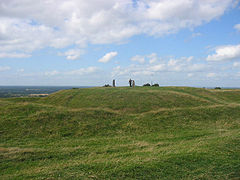
Summit
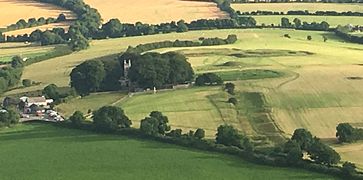
Aerial photograph
See also[]
- Gamla Uppsala – A village outside Uppsala in Sweden, historic residence of Swedish kings of the legendary Yngling dynasty
- Kingship of Tara – List of Kings of Tara (sometimes also High Kings of Ireland)
- Stonehenge – Neolithic henge monument in Wiltshire, England
- Tara Brooch, c. 7th century AD pennanular brooch named after, but not from Tara
- Faddan More Psalter, Book of Psalms, discovered 2006
- Hill of Ward, Close to Tara is the Hill of Ward, it's associated with the mythological druidess Tlachtga
- Hill of Uisneach – Hill in County Westmeath, Ireland, a druidic site associated with the festival of Bealtaine
References[]
- ^ Tara Hill - Cnoc an Temair , mountainviews.ie
- ^ 'Hill of Tara / Teamhair / Cnoc na Teamhrach'
- ^ Connellan 1846, pp. 246, notes.
- ^ Koch, John T. Celtic Culture: A Historical Encyclopedia. ABC-CLIO, 2006. p.1663
- ^ Halpin, Andrew. Ireland: An Oxford Archaeological Guide to Sites from Earliest Times to AD 1600. Oxford University Press, 2006. p.341
- ^ Jump up to: a b c d e f g h i j k l Andrew Halpin and Conor Newman. Ireland: An Oxford Archaeological Guide to Sites from Earliest Times to AD 1600. Oxford University Press, 2006. pp.341-347
- ^ "Hill of Tara". World History Encyclopedia. Retrieved 31 October 2017.
- ^ Jump up to: a b c Quinn, Colin. "Returning and Reuse: Diachronic Perspectives on Multi-Component Cemeteries and Mortuary Politics at Middle Neolithic and Early Bronze Age Tara, Ireland". Journal of Anthropological Archaeology, issue 37 (2015). pp.1-18
- ^ "Woodhenge - Tara". Knowth.com.
- ^ Jump up to: a b Newman, Conor (2007). "Procession and Symbolism at Tara". Oxford Journal of Archaeology, 26(4), pp.415-438
- ^ Bradley, Richard. The Past in Prehistoric Societies. Psychology Press, 2002. p.145
- ^ The Hill of Tara. Rough Guides. Retrieved 24 March 2013.
- ^ Jump up to: a b c Draft Tara Skryne Landscape Conservation Area. Meath County Council. 2010. Retrieved 24 March 2013.
- ^ "A Brief History of the Hill of Tara: Seat of Secular and Spiritual Power". A Trip to Ireland. 26 June 2013. Retrieved 31 October 2017.
- ^ Knowth.com photo of Samhain sunrise at the Mound of Hostages "The Stone Age Mound of the Hostages is also aligned with the Samhain sunrise." The sun rises from the same angle on Imbolc.
- ^ "Hill of Tara - County Meath, Ireland". www.sacred-destinations.com. Retrieved 31 October 2017.
- ^ Muldoon, Paul (25 May 2007). "Erin Go Faster". New York Times. Retrieved 7 September 2008.
- ^ Carew, Mairead (2003). Tara and the Ark of the Covenant: A Search for the Ark of the Covenant by British Israelites on the Hill of Tara, 1899–1902. Royal Irish Academy. ISBN 978-0-9543855-2-1.
- ^ Tara Ark of the Covenant, Newgrange
- ^ The Ark of the Covenant and Tara Hill, Stair na heireann
- ^ "History & Info | hilloftara.org". Retrieved 11 December 2019.
- ^ Dalgan, Columban Missionaries
- ^ Crossing a Rubicon at Tara, Tommy Hamill, Ballinter, Meath
- ^ Social History Ancient Ireland, Library Ireland Online
- ^ The Slighe Cualann, Henry Morris, Jstor
- ^ Conor Newman (2015) ‘In the way of development: Tara, the M3 and the Celtic Tiger’, in Meade, R. and Dukelow, F. (eds.) Defining Events: Power, resistance and identity in twenty-first-century Ireland, Manchester: Manchester University Press, 32-50.
- ^ Eileen Battersby (26 May 2007). "Is nothing sacred?". The Irish Times.
- ^ Glenn Frankel (22 January 2005). "In Ireland, Commuters vs. Kings". The Washington Post. p. A01. Retrieved 14 June 2007.
- ^ Paula Geraghty (24 September 2007). "In Ireland, Human Aerial Art at Tara: People power combines art protest and politics". . Retrieved 14 April 2008.
- ^ "The Hill of Tara". Sacred Sites International Foundation. Archived 25 July 2008 at the Wayback Machine
- ^ "2008 world monuments watch list of 100 most endangered sites" (PDF). Archived from the original on 7 June 2007. Retrieved 15 April 2008.CS1 maint: bot: original URL status unknown (link) World Monuments Fund.
- ^ Logue, Patrick (28 February 2009). "Tara endangered, says Smithsonian". Irish Times. Retrieved 26 August 2009.
Sources[]
- Connellan, Owen (1846). Philip MacDermott (ed.). The Annals of Ireland, translated from the original Irish of the four masters. O'Clery, Michael, 1575-1643 (electronic resource, Free eBook from the Internet Archive ed.). Dublin: B Geraghty, s. Anglesea street.
Further reading[]
- Petrie, George (1839), "On the History and Antiquities of Tara Hill", The Transactions of the Royal Irish Academy, Royal Irish Academy, 18: 25–232, JSTOR 30078991, alt link
- Macalister, R.A.S. (1919), "Temair Breg : a study of the remains and traditions of Tara", Proceedings of the Royal Irish Academy. Section C: Archaeology, Celtic Studies, History, Linguistics, Literature, Royal Irish Academy, 34 (1917–19): 231–399, JSTOR 25504215, alt link
- Raftery, Barry (1994), Pagan Celtic Ireland: The enigma of the Irish Iron Age, Thames and Hudson
- Bhreathnach, Edel, ed. (2005), The Kingship and Landscape of Tara, Four Courts Press, Dublin
- Newman, Conor (2007), "Misinformation, disinformation and downright distortion: the Battle to Save Tara 1999–2005", Uninhabited Ireland. Tara, the M3 and Public Spaces in Galway. Two Essays by Conor Newman and Ulf Strohmayer., Arlen House, Galway: 59–102, hdl:10379/1443
External links[]
| Wikimedia Commons has media related to Hill of Tara. |
- Hill of Tara at Megalithic Ireland
- Aerial photos of the monuments
- Heritage of Ireland, Tara
- Boyne Valley Tourist Portal – Information on Tara
- The Hill of Tara page on Mythical Ireland
- Bensen, Amanda (March 2010), "Ireland's Endangered Cultural Site", Smithsonian Magazine, 39 (12): 37, archived from the original on 19 May 2014
- Prehistoric sites in Ireland
- Archaeological sites in County Meath
- Mountains and hills of County Meath
- Tourist attractions in County Meath
- National Monuments in County Meath
- Royal sites of Ireland
- Former populated places in Ireland
- Sacred mountains
- Irish legends






